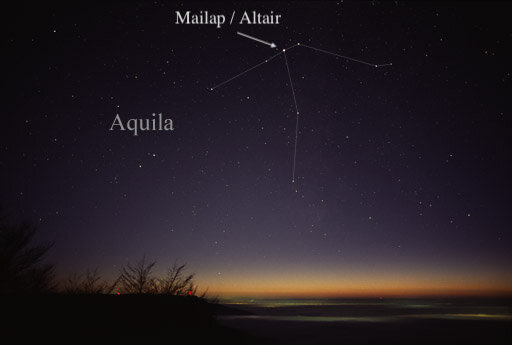Mwaey
Told by Isaac Lengal, Asor Island, Ulithi Atoll
Fiyong le ila sihasi mo wol, Asor, le Isaac Lengal mele ye fiyongo ngal gich
The purpose of this story is to introduce the skills needed for navigation – learning the position of the constellations is the first step. In the next story the knowledge of the location of Mailap will be assumed and won’t be explained. Mailap translates as the star Altair in the Aquila Constellation, or the tap root of a tree.
English
Ulithian
Here’s a story I heard from an elder from Fais. It’s been twenty-odd years since I heard this one.
Once upon a time on the island of Fais, there lived good old, Mwaey. And good old Lugeleng lived in the heavens looking down upon Fais Island. Every now and then, Lugeleng would come down and visit Fais. Mwaey lived at the end of the island in an opening of the cliffs there. He was covered with all kinds of skin diseases (abnormalities), which covered his whole body. Lugeleng came down and met with Mwaey. In this meeting Lugeleng asked Mwaey if he could borrow his skin.
And so, they magically exchanged skins. Mwaey was now wearing Lugeleng’s brilliant and sparkling skin while Lugeleng had on Mwaey’s infected skin. Lugeleng went to stay at the men’s house. Three sisters lived on the island. Their father asked them to prepare food for the visitor. None of them wanted to do the chore because they didn’t want to come close to this visitor. House flies and bugs were buzzing around the visitor’s body and face. The youngest daughter reluctantly did the chore, but when she was close enough to the men’s house, she threw the basket of food inside, turned around and went home. Although the food was delivered in an inhospitable manner, the youngest daughter still delivered it.
One day the man with all the fungus told the father of the three girls that he was going back home for a visit, since he’d been at the men’s house since his arrival on the island, and that he would only leave in the evening to watch people dancing and then return to his home. He asked for coconut oil to be delivered at dawn. The oil should be made from a copra facing the star Mailap (Altair in English). It was to be husked, ground, and delivered to his house. The oil was to be used when Lugeleng bathed in the early morning sea water before going back to his home.
Iye seew ilea iy rongrong moa irel semael mwal’al’apal’ Fais. Mal’boa bele riyeg mo toot raag yaey rongrong fiyong le.
Haelwe Mwaey ye ma mel woal Fais moa soelmal lefechig loal. Iwe ngoa haelwe Lugeleng yema mel woal l’aaeng yesa kakal’adi woal Fais. Yema chui moa woal l’aaeng, yesa bidiy woal Fais. Iwe ngoa Mwaey yema mel log tabol Fais ifael hoahoyael kawe. Le ye diugdiuglog irel ruub moa metmetael gil kawe ye hatareng. Ye buyoey moa irel melwe metal’ moa pangael lobos. Sa bidi Lugeleng. Mwaey sa l’a wiri, iwe ngoa sa kanglu boa, “Ay, yebe mal’ le hobe fang mel’a giilimw boa ibe taptap iyang?”
Iwe resa budog yusiuwlirlog. Mwaey yesa hasi melwe gil Lugeleng we ye tarfisfis ngoa ye bulbul. Iwe ngoa Lugeleng yesa hasi iwe gil we yetaikof. Lugeleng sa log, sel’a mel irel melwe fal’er reFais. Iwe ngoa iy melwe temaer ir lefechig kawe sa kaenglur boa, rebl’a foer mongoay. Yesa kaenglur boa, “Semael hami yebe hasi di mongoay le boa hael mwaal’ l’a ye mel ilael fal’ laiy.” Semael ngoa te depal’ boa retedipli melwe boa rebl’a bidi ngoa ye nguungung fedal’ laang tamwol uwooal boa ye choelog irel ruub le ye ppey wol melwe metal. Iwe ngo metwe miril yarmat mele ma soar mechael bo ma hasidi chog melwe, sa pidaeloang lal fal we, sa taegul, sa tefael. Te ma hamalmale, ngo ligdi mo ma hasidi, sela fang. Seral ngo iewe sa loloh.
Constellation Aquila, with the star Altair (Mailap) in the evening sky.
© Till Credner, AlltheSky.com
La relawe seral, ngo ie gilsobow we ma mel lal fal we sa kanglu molwe temar lefechig kowe bo, “Ai, walsu mele ibe bidah, ible tefal mo moirel mala imey bo ite ma doh loh solbos bo iema pei chog iga. Lobong chog mele ima buyuy, islae kamahoy barog, isa tefalong. Iewe, iewe be lemaral la ngo hosala hasi chog la hapdei. Le hobla meri sew cho teye telaloh fael Mailap. Yong hosa hasi, bo hobe hodmi, hosa guru, hosa hasi di bo ila mala ibele la mol irel dudu, ngo ible moch bidah irel imla imey.”
Early the next morning, the father of the three girls went in search of the copra facing Mailap. He picked a big, newly fallen copra, husked it and ground it. The father again asked the three daughters to deliver it the man. Again, the first daughter refused and so did the second daughter. The youngest daughter took the ground copra and went to the men’s house to Mwaey. This time she didn’t throw the copra inside the house. She called and Lugeleng came out to receive the copra. He asked the daughter to go bathe with him. She followed him at a distance because of the smell emitting from all the fungus covering his head. She followed him to the western end of Fais island. Lugeleng bathed, then walked to the cliffs there and asked Mwaey for his skin back, saying, “To each his own.”
As he made his way around that side of the island overlooking the cliffs with his new skin, displaying brilliant and shining tattoos, Lugeleng surprised the youngest daughter. She was so overcome with astonishment that she gathered the leftovers of the ground copra and began eating them. Such was her surprise as she thought to herself, “He’s not an ugly man after all, but rather a handsome and magnificent fellow.” They went back to her father’s house. The father had suspected from the beginning that the man occupying the men’s house had some sort of magical status. And Lugeleng and the youngest daughter got married and lived in the daughter’s home with their father happily ever after.
The End – Iewe ngo sa titi mata mayomayo.
Iewe, lemaral chog ngo mal we sa loh. Molwe temar lefechig kowe sa loh, sala meri ie cho we ye tele loh fael Mailap, sa hasi sew chomer kowe ye palingling, sa budoh hodmi. La mol sa guru. Iewe ngo sowa ngalir mokwe lol lefechig we sulmol. Ngalei semal ngo teyemechel hasi. Ngalei semal temchel hasi. Miril yarmat we mele yewol hasi cho we sa mol irel gurgur, sa bidi. Tai pedi long bo sa mwalili, sa buyuy, sa ngalei. Ieong sa kanglu bo, “Dabeyey bo ibe loh. Ibla dudu, ngo siya tefal.” Iewe sa dabey mirel le tepel molwe yor le be dedar bo ie Lugeleng we taimal gilsobow kowe wol molwe chemal le be mel mo halungguy ngo ie ye pei mo iga. Yal dedabey miril resa bibidi mo tabol Fais la meldow. Sa bidi remtawe, sa dudu ye la mol, ngo ye tawe loh mo lugul hogyal kowe. Sala kangal Mwaey bo, “Fang molwe giley bo semal gich ngo yehasi gil.”
La tegul doh mo rewe sera le, sa tefal ngal molwe gil Lugeleng we – mokwe mekkel we ye tarfisfis. Fefel we la kaldi, “Ngak!” Yalbidi sa budoh madgo mokwe guwal cho we, sa hangi. Irel lepal yal rai irel molwe sa moch hola bo, “Ai, tesemal mal hatereng wululul molwe bo [semal tarmwal kamdidi].” Yong resa bedah, resa bedah chog, resa loh irel molwe temar. Ie molwe termar, fesul. Tepel molwe sor rok lal depal, bo towe si le semal yarmat le yor iegegal mele sala budoh mel lal fal le. Iewe resa bidah, resa bidah riri loh, resa pei irel imwe imal faefel we mo molwe temal.
Iewe sa wol titi mata mayo mayo, hami mo. Ngang isa hatach yal, yong semal hami be hawele, ngo semal hami sa hapale loh.


